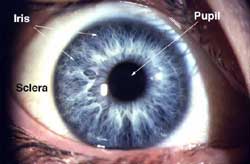Eye Consideration
Eye Adaptation
 Just as lighting is an important consideration in the inspection process, so is the eye's response to light. Scientists have recently discovered that a special, tiny group of cells at the back of the eye help tell the brain how much light there is, causing the pupil to get bigger or smaller. The change in pupil diameter is not instantaneous, therefore, eyes must be given time to adapt to changing lighting conditions. When performing a fluorescent magnetic particle inspection, the eye must be given time to adapt to the darkness of the inspection booth before beginning to look for indications. Dark adaptation time of at least one minute is required by most procedures. Some studies recommend adaptation time of five minutes if entering an inspection area from direct sunlight. Inspectors should carefully adhere to the required adaptation time as it is quite easy to overlook an indication when an inspection is started before the eyes have adjusted to the darkened conditions.
Just as lighting is an important consideration in the inspection process, so is the eye's response to light. Scientists have recently discovered that a special, tiny group of cells at the back of the eye help tell the brain how much light there is, causing the pupil to get bigger or smaller. The change in pupil diameter is not instantaneous, therefore, eyes must be given time to adapt to changing lighting conditions. When performing a fluorescent magnetic particle inspection, the eye must be given time to adapt to the darkness of the inspection booth before beginning to look for indications. Dark adaptation time of at least one minute is required by most procedures. Some studies recommend adaptation time of five minutes if entering an inspection area from direct sunlight. Inspectors should carefully adhere to the required adaptation time as it is quite easy to overlook an indication when an inspection is started before the eyes have adjusted to the darkened conditions.
Ocular Fluorescence
When ultraviolet light enters the human eye, the fluid that fills the eye fluoresces. This condition is called ocular fluorescence, and while it is considered harmless, it is annoying and interferes with vision while it exists. When working around ultraviolet lights, one should be careful not to look directly into lights and to hold spot lights to avoid reflection. UV light will be reflected from surfaces just as white light will, so it is advisable to consider placement of lights to avoid this condition. Special filtered glasses may be worn by the inspector to remove all UV light from reaching the eyes but allowing yellow-green light from fluorescent indications to pass. Technicians should never wear darkened or photochromatic glasses as these glasses also filter or block light from fluorescent indications.